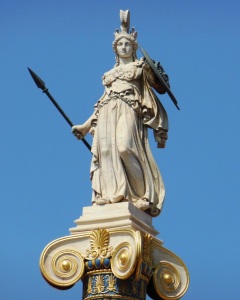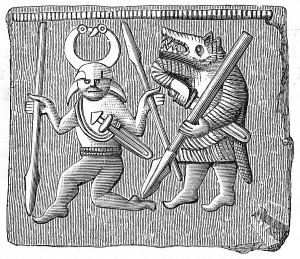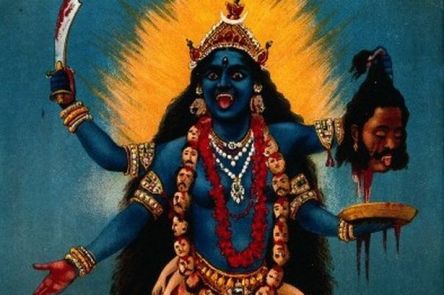In this post I look at the origins of the gods and goddesses of the Warhammer background, starting with the main deities of the WFRP1 rulebook.
MANANN
Manann seems to be a conflation of European sea gods. His name comes from the Celtic sea god Manannán mac Lir. However, his character and appearance more closely resemble that of the Greek god Poseidon, especially with respect to the common symbol of a trident.

Poseidon
MÓRR
Mórr also draws on a number of sources. His symbol of the raven derives from the Celtic goddess the Morrígan and the Valkyries of Norse myth. The connection of dreams and death is classical (the Greek gods Thanatos, Hypnos and Morpheus are related). The connection with doors also echoes classical ideas of gateways to the underworld, and possibly recalls the Roman god Janus. The name is probably derived from the Latin mors (“death”).
TAAL
Taal is clearly the Celtic god Cernunnos. This is emphasised by the equation of Taal with the elf god Karnos (see Warhammer Companion, p21, reprinted in Apocrypha Now, p67), whose name clearly derives from Cernunnos. I cannot, though, discern the origin of the name Taal.

Cernunnos
RANALD
The inspiration for Ranald seems to have been the Norse god Loki. The name may simply be a corruption of Ronald. (It might even have been intended as a contemporary cultural reference, perhaps to Ronald Reagan or Ronald McDonald.)
MYRMIDIA
There are many war deities in European myth that could have influenced the conception of Myrmidia. However, a number of them can probably be disregarded. The Greek Ares and Norse Odin are masculine. The Morrígan of Celtic myth and Valkyries of Norse are linked more with death on the battlefield than military strategy and discipline. The deity Myrmidia most closely resembles is the Greek goddess Athena in her martial aspect. The resemblance extends to their physical appearance: both are depicted wearing a helmet and carrying a spear and shield.
The name also seems to have a classical origin: the Myrmidons were the warriors who accompanied Achilles in the Trojan War.

Athena
SHALLYA
The common motif of tears makes the Celtic influence clear in this case. Shallya derives from the goddess Airmed, whose tears had healing power. The origin of the name, however, eludes me. There is a Gallic goddess of healing that the Romans called Sirona. There is a Welsh word gwella, meaning “heal”. But I am clutching at straws. I really have no idea where the name comes from.
VERENA
This deity seems to be the another modelled directly on the Greek goddess Athena. Both are goddesses of learning and wisdom. Verena is depicted in a pseudo-classical garb and shares the owl symbol that was Athena’s. I strongly suspect the name derives from the combination of Athena and the Latin verus (“true”).
ULRIC
Ulric seems to be an embodiment of the warriors of Norse myth, especially the ulfhedhnar. The name seems to be a modification of the Nordic name Ulrich, possibly under the influence of Moorcock’s Elric.

Ulfhedhinn
KHÁINE
Kháine bears an interesting resemblance to the Hindu deity Kali: four arms, a leering mouth and a garland of skulls. If so, it is an unusual departure from European sources of inspiration. I am unsure as to the origin of the name; possibly Kali and the Biblical Cain were influences.

Kali
RHYA
There are many mother deities in real-world mythology, but the druidic context makes the Celtic goddess Danu the most likely archetype here. I am unsure of the origin of the name, but it could be the English word rye.
SIGMAR
Sigmar was created by Phil Gallagher. The name is a variation of Siegfried from Wagner’s Der Ring des Nibelungen, as discussed here.
GRUNGNI
Like the other non-human deities Grungi seems not to be based on a mythological deity, but on a stereotype of the race in general. Mythology may have contributed the name, however: Odin’s spear was Gungnir.
LIADRIEL
This name would seem to have been derived from Galadriel in The Lord of the Rings. The other element in the name is perhaps the English word lyre.
ESMARALDA
There can be little doubt the name of this deity is the Iberian first name. Although the name was famously used by Victor Hugo, it is likely that it came to be used in this context because of different literary source: Tolkien used it of hobbits (eg Esmaralda Brandybuck).
OVERALL
It is clear that for the most part the deities above are pastiches of historical deities, especially classical and Celtic ones. That is very much in keeping with the pseudo-historical feel of the Warhammer setting, and very probably made the setting more accessible to its audience.
One question I have never seen discussed is who was behind these deities (with the exception of Sigmar). Graeme Davis has commented before that he worked extensively on the religion section of the WFRP1 rulebook, but that does not necessarily mean that he was the originator of the gods and goddesses it contains. They do, though, bear some of the hallmarks of his work: allusions to historical mythology, especially Celtic, and Latin-inspired names. And most of these deities did not appear in print until WFRP1. Yet the god Taal appeared in the Spring 1986 Citadel Journal. That is close to the time Davis joined GW, but it might mean Taal existed before Davis worked on this material.
The second part of this post will cover the deities of Law and Chaos.
Images used without permission. No challenge intended to the rights holders.
I’ve always assumed that, along with the classical allusions, Morr had some inspiration from Odin: obviously both are gods of death and the dead, ravens were sacred to both and both are also gods of magic (with Morr linked to illusionists).
As for the origin of the name Taal, I thought it probably derived from the German word ‘tal’ for valley – suitably rural and wild.
The gods in general steal from real European pagan pantheons but often split functions of gods that might be inspirations (such as Athena) or combine them to some extent. Overall I think this helped in creating gods and goddesses that felt as though they could have existed. Other aspects of religion were, perhaps, not handled so well but I see you are planning other posts on the gods…
LikeLiked by 1 person
All good points.
I’m interested in the other aspects of religion you don’t think work. I am actually putting together a separate post on some other aspects of religion, including some different ideas on in-game religious life.
LikeLike
All right – here’s what I remember (and what I’m prepared to admit to, he said with a grin):
Manann: spot on, a conflation of Manannan and Poseidon. I made him up to fill out the ranks when I was writing the Religion and Belief chapter.
Morr: came out of a discussion I had with Jes Goodwin over coffee one day. I can’t remember how the subject came up. I wrote him up for the rulebook, and developed some further ideas which found their way into Apocrypha 2. The name does indeed come from the Latin “mors.”
Taal was in the draft I got from Rick and Hal: I’m thinking he was Rick’s creation, but I don’t know for sure. The antlers make the Cernunnos link very clear.
Ranald was either Rick or Hal. I believe the name was inspired by two famous London villains of the 1960s: Great Train Robber Ronald Biggs (who was still infamously living the high life in extradition-free Rio at that time) and dreaded gangster Ronald Kray.
Myrmidia was mine. If Ulric was a berserker god, I wanted a god of more scientific warfare, like Pallas Athena as you rightly say. The name is indeed inspired by the Myrmidons. Creating Myrmidia inspired me to develop two semi-parallel pantheons to reflect cultural tensions in the Old World: the “town gods” or “southern gods” like Myrmidia and Verena were more classical, and the “country gods” or “northern gods” like Taal and Ulric were more Celtic-Germanic.
Shallya was just a random sound I came up with that seemed to fit the nature of the goddess. It means nothing – although Tony Ackland used to tease me about it, suggesting that Shallya should have a sister named Shantya!
Verena is mine again, modeled on Athena as the patron of wisdom and learning. I think. I have a vague memory of something about her in the pre-Davis draft, perhaps under another name. In the Rick and Hal version, she was a mix of Athena and Hera, with a healthy dose of market-place gossip thrown in. There was a joke about the price of eggs, but I can’t remember any more than that. Sorry – I know that must be frustrating.
Ulric was Rick, Hal, and/or Bryan, very Nordic sounding and a perfect patron for berserkers and wolves. I don’t think I changed anything about him in editing.
Khaine was created by Jes when he did his big revamp of the Dark Elves in ’86. I extended his domain to include assassins of other races. I believe Jes took the name from Cain in the Old Testament.
Sigmar was indeed created by Phil and Jim when they were developing the Empire for TEW. I believe he was modeled on the hammer-wielding character from the cover art in the 1st and 2nd edition WFB boxed sets (who up until that time had been called “Harry the Hammer” – according to Aly Morrison at least).
Grungni, Liadriel, and Esmeralda were all me. The original draft of WFRP included no gods for the nonhuman races, so I rushed in one of each just to show willing, and hoped to have a chance to fill out the nonhuman pantheons later: sadly, opportunities were rare. Grungni and Liadriel were both made-up, right-enough-sounding names with no particular inspiration; I didn’t take Esmeralda from Victor Hugo on purpose, but I didn’t avoid the name for that reason either. It just sounded like a nice, cosy name for a divine ancestress of Halflings: sort of a seven-times-great aunt by marriage, if you will.
LikeLiked by 2 people
I had always assumed that Khaine — the god of murder — got his name from Cain — the first murderer — via a bit of misspelling to make it seem more celtic. I think itmay be just as simple as that.
There is a reference to Manaan in TSR UK’s The Sinister Secret of Saltmarsh; I thought this could have been a proto-WFRP reference given the connections between TSR UK and GW, but it’s probably just a case of both using the same celtic god as inspiration.
LikeLiked by 1 person
The spelling of Kháine follows Sláine, I suppose. Does that mean it should be pronounced “Kanye”? Perhaps he’s also god of rhyme…
LikeLiked by 1 person
Another great post. I always associated Ranald with Reynard the Fox and folklorish trickster figures like Till Eulenspiegel. But I like Graeme’s explanation too!
LikeLiked by 1 person
Dry_Erase, that is how I developed him ( with a dose of the Grey Mouser thrown in), but the name was already there.
LikeLiked by 1 person
Ah! That makes perfect sense. I’ve always liked Ranald and felt he was overlooked in official and unofficial material.
LikeLike
I am sure I have missed lots of these subtleties in the post above, which is frankly a bit reductionist.
LikeLike
I always thought Rhya was from Freya in the Norse pantheon. Great post Mr Gideon! It brings back so many thoughts I had when reading WFRP thirty years ago, some of which seem to have been close to the mark. But yet so many more interesting twists. A great world set up that I hope is continued by the new stuff. It really would, be good if a few of the creators of the original material were in on future developments. Along with those who have kept it alive. Is Mr Davis likely to have a hand in it I wonder?
LikeLiked by 1 person
I always thought that Shallya’s name was partially inspired by the RuneQuest godess Shalana Arroy. They definitely sound similar!
LikeLiked by 1 person
There’s a similarity in the names, and they are both goddesses of healing. However, it looks to me as though the normal spelling is Chalana Arroy: https://glorantha.fandom.com/wiki/Chalana_Arroy. I’m no expert on Glorantha, though.
LikeLike